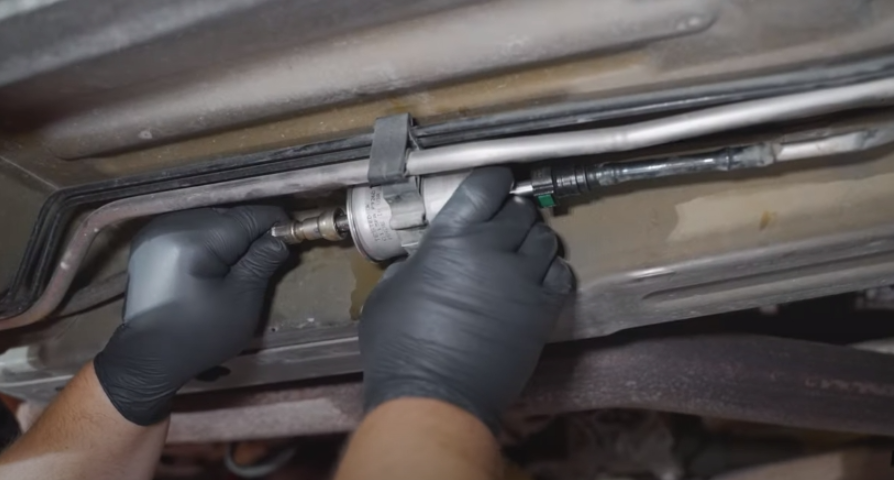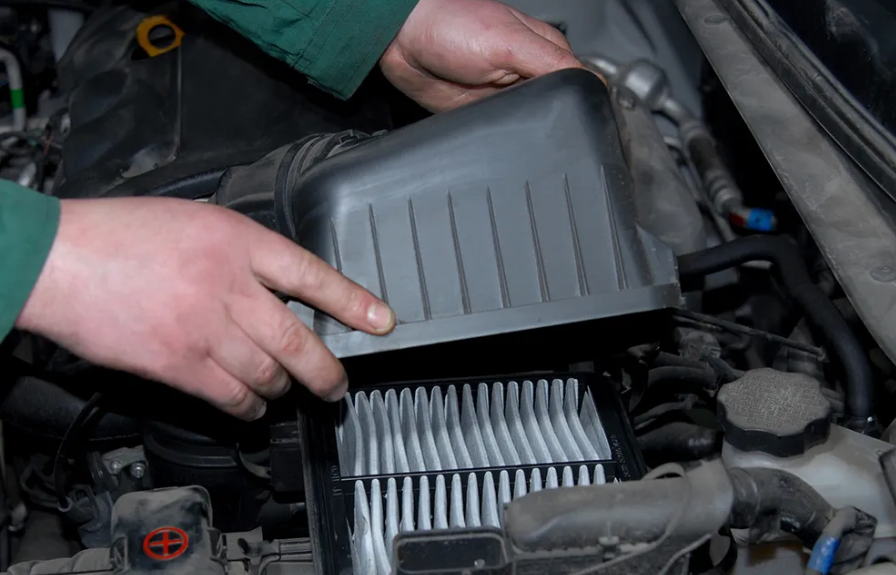A clogged Mustang fuel filter can create a loss of pressure by restricting fuel flow to the engine. This causes the fuel pump to work harder, leading to performance issues like stalling or hesitation.
If you’re driving a Ford Mustang and noticing a decrease in performance or strange engine behavior, one potential cause could be a clogged fuel filter. This seemingly small part plays a huge role in ensuring that clean fuel flows into your engine at the proper pressure. When the fuel filter becomes clogged, it can cause a loss of fuel pressure, leading to a range of symptoms that can negatively affect the car’s performance.
In this article, we’ll explore how a clogged fuel filter can lead to a loss of pressure in the Mustang, how to spot the signs of a problem, and what you can do to resolve it.

Contents
- 1 What is a Fuel Filter and How Does It Work?
- 2 Can a Clogged Fuel Filter Cause Loss of Pressure in a Mustang?
- 3 Symptoms of a Clogged Fuel Filter in Mustang
- 4 Diagnosing the Problem: How to Check for Low Fuel Pressure
- 5 Replacing the Fuel Filter in the Mustang
- 6 Preventing Clogged Fuel Filters
- 7 Frequently Asked Questions
- 8 Conclusion
What is a Fuel Filter and How Does It Work?
A fuel filter is a critical part of the vehicle’s fuel system. It’s designed to catch impurities and debris that may be present in the gasoline before they reach the engine. The fuel filter ensures that only clean fuel enters the fuel injectors, preventing contamination that could harm your engine. Over time, as the filter performs its job, it collects more dirt and debris, which can lead to the filter becoming clogged.
In most Mustangs, the fuel filter is located along the fuel line, typically near the fuel tank or under the car. The filter works by allowing fuel to pass through its small pores, which trap any particles larger than a certain size. These particles can include rust, dirt, and even metal shavings that can find their way into the fuel system.
Can a Clogged Fuel Filter Cause Loss of Pressure in a Mustang?
Yes, a clogged fuel filter can definitely cause a loss of fuel pressure in your Mustang. The fuel system in your car is designed to operate at a specific pressure, which is necessary for the proper functioning of the engine. When the fuel filter becomes clogged, it restricts the flow of fuel to the engine, which can reduce the fuel pressure, leading to a variety of engine performance issues.
Here’s a breakdown of how a clogged fuel filter can cause a loss of pressure:
- Restricted Fuel Flow: When the filter becomes clogged with dirt and debris, it restricts the flow of fuel. This means that not enough fuel is able to reach the engine, which can lead to a drop in fuel pressure. If the fuel pressure drops too low, the engine may struggle to run efficiently, causing stalling, poor acceleration, or difficulty starting the car.
- Strain on the Fuel Pump: The fuel pump is responsible for pushing fuel through the fuel lines and into the engine. When the filter becomes clogged, the pump has to work harder to push fuel through the restricted filter. This added strain on the fuel pump can lead to premature wear and eventual failure of the pump.
- Inconsistent Fuel Supply: A clogged fuel filter can also lead to inconsistent fuel supply, which affects engine performance. The engine may experience fluctuating power, hesitation during acceleration, or misfires because the fuel injectors are not receiving a steady, consistent flow of fuel at the proper pressure.
Symptoms of a Clogged Fuel Filter in Mustang
It’s essential to catch the signs of a clogged fuel filter early to prevent serious engine damage. Here are some common symptoms that can indicate a clogged fuel filter is causing a loss of pressure in your Mustang:
1. Hesitation or Stalling
If your Mustang hesitates or stalls when you try to accelerate, it could be due to insufficient fuel being delivered to the engine. A clogged fuel filter restricts fuel flow, which leads to engine hesitation or complete stalling, especially during high-demand conditions, such as rapid acceleration or going uphill.
2. Difficulty Starting the Engine
A clogged fuel filter can make it difficult for your Mustang to start. When the filter is blocked, the engine doesn’t get enough fuel to fire up properly. You might notice that the engine cranks but fails to start, or it may take several tries before the car finally starts.
3. Decreased Fuel Efficiency
If your Mustang suddenly begins to consume more fuel than usual, it could be a sign that the fuel filter is clogged. When the filter restricts fuel flow, the engine compensates by using more fuel to make up for the reduced supply. This results in decreased fuel efficiency and more trips to the gas station.
4. Engine Misfires
A clogged fuel filter can lead to inconsistent fuel delivery, causing the engine to misfire. Misfires occur when the fuel-air mixture in the cylinders is not ignited correctly. This can cause rough idling, shaking, and poor acceleration. Misfires can also trigger the check engine light, which is another sign that something is wrong with your fuel system.
5. Check Engine Light
A drop in fuel pressure caused by a clogged fuel filter can trigger the check engine light on your dashboard. While the check engine light can be caused by many different issues, a clogged fuel filter is one possibility, especially if you’re experiencing symptoms like poor acceleration, stalling, or misfires.

Diagnosing the Problem: How to Check for Low Fuel Pressure
If you suspect that a clogged fuel filter is causing a loss of fuel pressure in your Mustang, you can perform a fuel pressure test to confirm. Here’s how:
Step 1: Locate the Fuel Pressure Test Port
In most Mustangs, the fuel pressure test port is located on the fuel rail, near the engine. You’ll need a fuel pressure gauge, which you can purchase or rent from an auto parts store. The gauge is designed to attach to the test port so you can measure the fuel pressure in the system.
Step 2: Attach the Fuel Pressure Gauge
Once you locate the test port, attach the fuel pressure gauge to it. Be sure to follow safety precautions, as fuel can spill during this process. Make sure you’re working in a well-ventilated area, and wear protective gloves and eyewear.
Step 3: Measure the Fuel Pressure
Turn the ignition key to the “on” position (without starting the engine). The fuel pressure gauge should give you a reading of the pressure in the fuel system. Compare this reading to the specifications in your Mustang’s service manual. If the pressure is too low, it’s a sign that there may be a problem with the fuel filter or another part of the fuel system.
Replacing the Fuel Filter in the Mustang
If a clogged fuel filter is causing a loss of fuel pressure, the only solution is to replace the filter. Here’s how you can replace the fuel filter in your Mustang:
1. Locate the Fuel Filter
In most Mustangs, the fuel filter is located along the fuel line under the car, near the driver’s side. Consult your Mustang’s owner manual for the exact location.
2. Relieve the Fuel System Pressure
Before removing the filter, relieve the pressure in the fuel system to avoid any fuel spray. You can do this by removing the fuel pump fuse and starting the car to let it run until it stalls.
3. Remove the Fuel Lines
Use the appropriate tools to disconnect the fuel lines from the filter. Be sure to have a container or rags nearby to catch any residual fuel that may leak out.
4. Install the New Filter
Position the new fuel filter in the same orientation as the old one. Secure it with mounting bolts, and then reconnect the fuel lines to the filter.
5. Test the System
Turn the ignition key to the “on” position to pressurize the fuel system. Check for leaks and make sure the engine starts smoothly.
Preventing Clogged Fuel Filters
To prevent future fuel filter issues in your Mustang, here are a few tips:
- Use High-Quality Fuel: Always purchase fuel from reputable gas stations to reduce the amount of contaminants in the fuel.
- Regular Maintenance: Follow the recommended maintenance schedule for your Mustang, which includes replacing the fuel filter every 30,000 to 40,000 miles.
- Avoid Low Fuel Levels: Try not to let your fuel level get too low, as running on empty can cause sediment to build up in the filter.
Frequently Asked Questions
Here are some FAQs about clogged Mustang fuel filter –
1. How often should I replace the fuel filter in my Mustang?
It’s recommended to replace the fuel filter every 30,000 to 40,000 miles, but this may vary depending on your model and driving conditions.
2. Can a clogged fuel filter cause my Mustang to stall?
Yes, a clogged fuel filter can lead to stalling, as it restricts the flow of fuel to the engine, making it difficult for the car to maintain idle speed.
3. How can I tell if my fuel filter is clogged?
If you experience poor acceleration, difficulty starting, engine misfires, or decreased fuel efficiency, these could be signs that your fuel filter is clogged.
4. Can I clean a clogged fuel filter instead of replacing it?
While some filters can be cleaned, it’s usually best to replace a clogged fuel filter to ensure that the fuel system works efficiently.
5. How do I test the fuel pressure in my Mustang?
To test fuel pressure, you’ll need a fuel pressure gauge, which you can attach to the fuel rail. Check the reading against the specifications in your vehicle’s manual.
Conclusion
A clogged fuel filter can cause a loss of fuel pressure in your Mustang, leading to poor engine performance, stalling, and other issues. It’s essential to be aware of the symptoms of a clogged filter and replace it promptly to avoid further damage to your fuel system.




